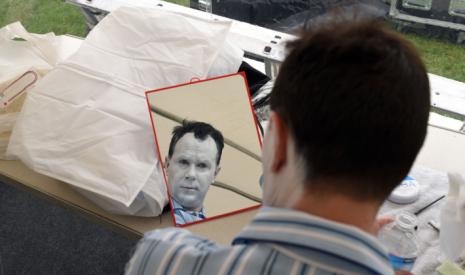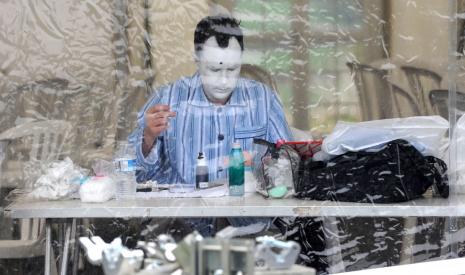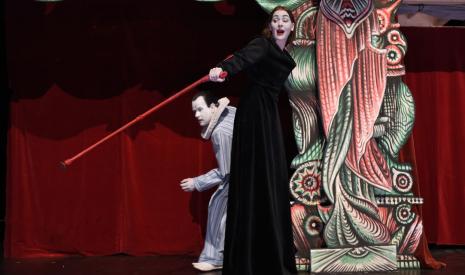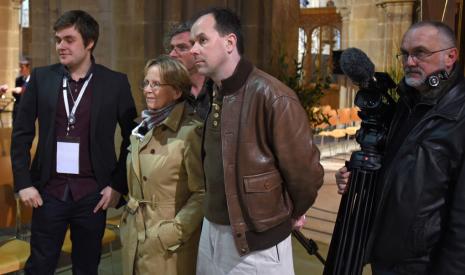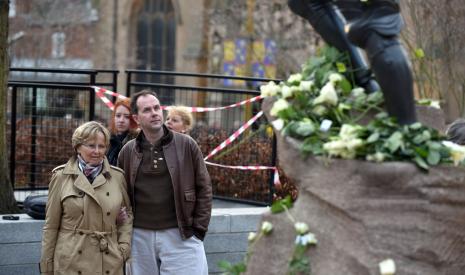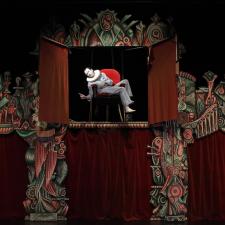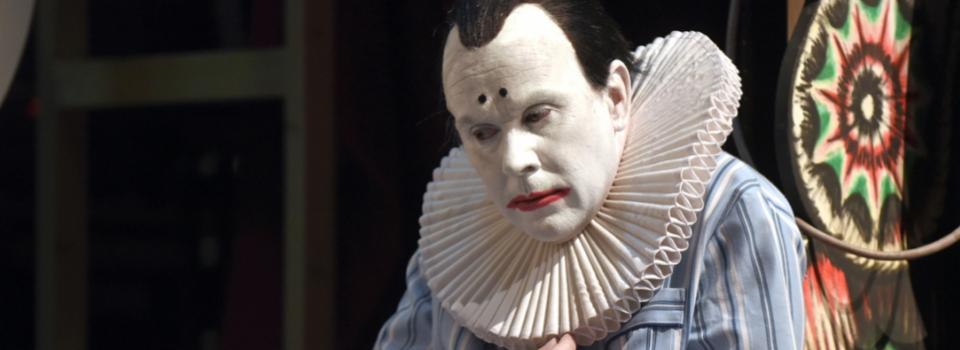
Richard III – Loyaulté me lie # 18
Ghosts and spectres (3/3)
“Stay away from actors. Their skin is a magnifying glass against which ghosts rub their insides, leaving behind a cloud of wild rose and musk that embalms your eyes with an odyssey of dreams.”
“At the seat of our eyes, an actor leaves the dead to bury the dead. For each one of them, the actor offers the signs and syllables that marked their lives. In the heart of humans, these hunters croak what is unknown to humans.”
Jean Lambert-wild, Demain le théâtre, published by Les Solitaires Intempestifs, 2009.
Attentively listening to signs and to ghosts is something that is everywhere in Jean Lambert-wild’s work. Every time, ghosts know how to cunningly organise themselves and make themselves known at an opportune time.
According to Jean Lambert-wild, his clown is a hotel for ghosts. A whole imaginary bestiary lives inside of him. He is the companion of the Nephilim, the cousin of the Loas, the brother of the irritated Manes. He likes to chat with the invisibles. He entertains himself by throwing salt over his shoulder to immobilise the shadows of bad spirits. He tends a garden where he grows little imps and harvests tears, laughter, anger, love and silent melancholies. He reaps emotions that are as mysterious as they are unreasonable. It is sometimes tragically ridiculous, but often it is softly funny.
The long marinating process of the actor’s substance in the strange spices of a magical world is not without consequences. The clown cannot, for instance, go on stage without wearing his pyjamas. This magic garment allows him to welcome the invisible tenants that Jean, in a dyslexic contraction, calls his guests. Gérald Garutti and Lorenzo Malaguerra had to accept this with goodwill. If they had sartorial temptations, they were quickly countered by the clown’s helpless and irate expression. For the clown, respecting emblems and symbols is a prerequisite to his existence, and it is what allows his voice to resonate. In the words of Richard: the joy and the fury of the clown’s performance cannot exist without these “old odd ends”.
When we saw Elodie Bordas marry her own ghosts to Jean’s ones, we all convinced ourselves we had to accept this conversation between the ghosts if we wanted to stage Shakespeare.
What we call chance, destiny or our lucky star is often no more than the result of our ability to hear and accept signs. Comes a time when, if we want to go beyond ourselves, we have to trust the underground conversations that guide our steps towards beings that we have hoped for, towards an “again” that suggests there is something more than ourselves, towards friendly charms that release language, towards hidden self-evident facts that strengthen our reason with an unreasonable intensity of life. A way of living that, because it is no longer the actor’s, can become the audience’s.
This is when, at the end of the year 2012, having decided to work on William Shakespeare’s Richard III, we heard that the remains of Richard III had just been discovered under a car park in Leicester. Between the time of this discovery in September 2012 and the reinternment in March 2015, we followed the events with great attention. This discovery, nearly five centuries after Richard III’s death, became an important sign that increased our desire to stage Shakespeare’s masterpiece. And however incredible this might seem, we found it all even more amusing when Jean discovered, from a trustworthy source: his own mother, that the surprises of genealogy meant King Richard was a distant cousin of his.
Performing with ghosts might allow us to hold in the same space the tragic last words of Shakespeare’s King Richard, and the footage we were allowed to film during the reinternment of the real King Richard. In a sign of magical familial devotion, Jean and his mother attended these celebrations to pay their last respects to their strangely reappeared ancestor.
- Richard III – Loyaulté me lie # 01
- Richard III – Loyaulté me lie # 02
- Richard III – Loyaulté me lie # 03
- Richard III – Loyaulté me lie # 13
- Carnet de bord # 16 Richard III – Loyaulté me lie
- Carnet de bord # 17 Richard III – Loyaulté me lie
- Carnet de bord # 18 Richard III – Loyaulté me lie
- Carnet de bord # 19 Richard III – Loyaulté me lie
- Carnet de bord # 20 Richard III – Loyaulté me lie
- Carnet de bord # 21 Richard III – Loyaulté me lie
- Carnet de bord # 22 Richard III – Loyaulté me lie
- Carnet de bord # 23 Richard III – Loyaulté me lie
- Richard III – Loyaulté me lie # 04
- Richard III – Loyaulté me lie # 05
- Richard III – Loyaulté me lie # 06
- Richard III – Loyaulté me lie # 07
- Richard III – Loyaulté me lie # 08
- Richard III – Loyaulté me lie # 09
- Richard III – Loyaulté me lie # 10
- Richard III – Loyaulté me lie # 11
- Richard III – Loyaulté me lie # 12
- Richard III – Loyaulté me lie # 14
- Richard III – Loyaulté me lie # 15
- Richard III – Loyaulté me lie # 16
- Richard III – Loyaulté me lie # 17
- Richard III – Loyaulté me lie # 18
- Richard III – Loyaulté me lie # 19
- Richard III – Loyaulté me lie # 20
- Richard III – Loyaulté me lie # 21
- Richard III – Loyaulté me lie # 22
- Richard III – Loyaulté me lie # 23
- Richard III – Loyaulté me lie # 24

